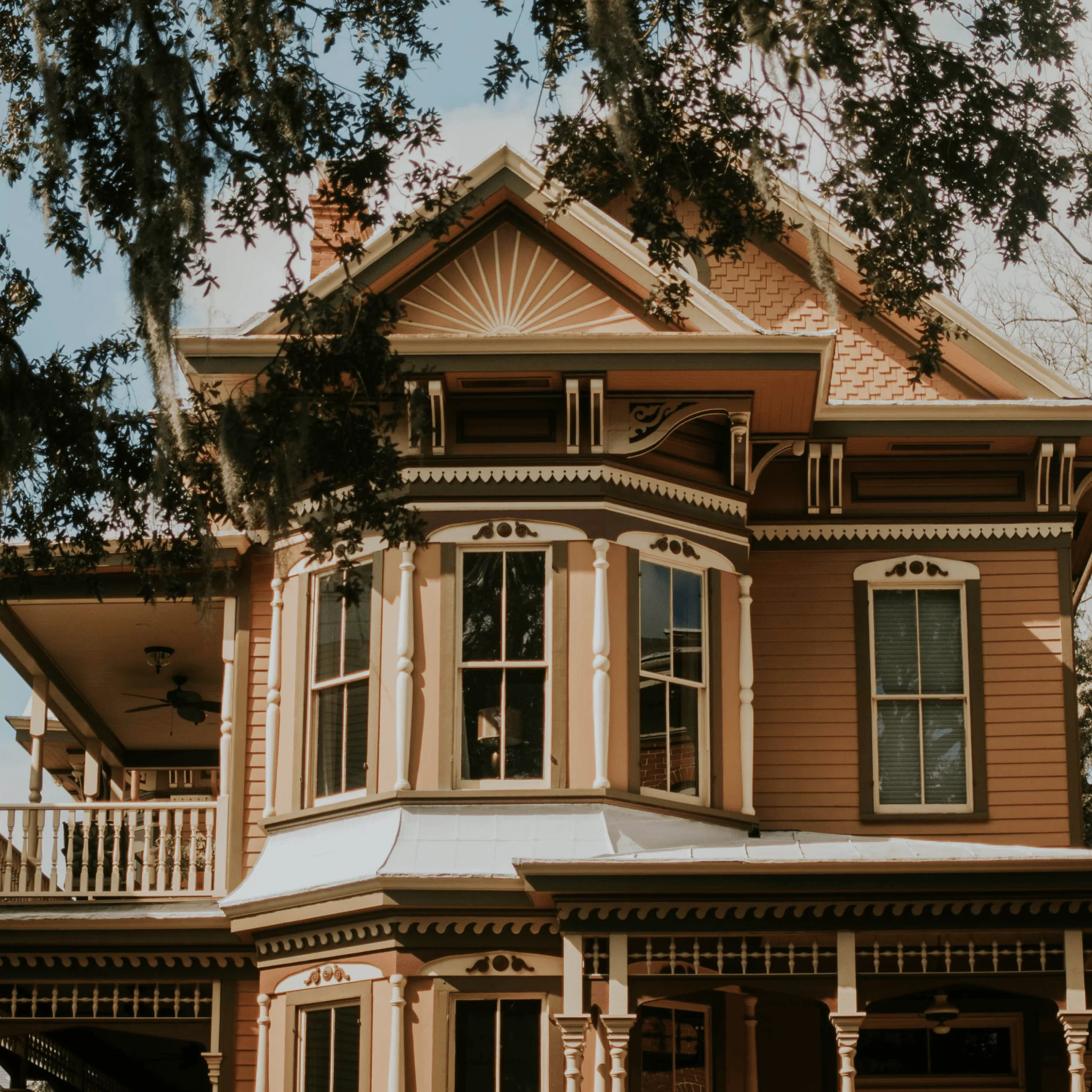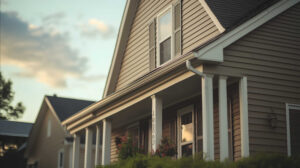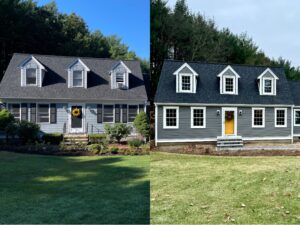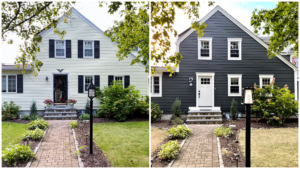

Project Manager at Plum ProExteriors
Top Siding Choices for Historic Homes

Every old house once looked great, but over the years, the siding of any house needs to be replaced. If you own a house with a historic exterior, you need to put in some effort to restore the old look that has faded. At Plum ProExteriors, we can help you replace your siding and make it better than before.
When it comes to the old house siding types, you have a lot of options to choose from. These include vinyl siding, metal siding, wood siding, composite siding, and more.
If you want your historic home to retain its distinctive look, you should carefully select the type and durability of the siding. In this article, we will look at the main factors to consider when carrying out repair work to replace siding. Let’s start!
Definition of the historic home and its specifics
Typically, we can call a house historic when it is at least 50 years old. But the definition of a house as historic may vary depending on the location or authority. It also matters whether the house has any historical value other than its age (which is an important factor). Many houses that have this value are included in the national register and are protected by the government.

Challenges of preservation of the historic home
Older homes with historic value have distinctive architectural elements that reflect the era’s culture. These homes immediately stand out from modern homes. What’s challenging about restoring these homes? This process can involve intricate moldings, custom woodwork, and intricate designs characteristic of a particular period.
Another challenge that siding professionals face is updating such a house in accordance with modern standards while maintaining their unique style. Government regulations can also hinder restoration work, so it is necessary to take care of obtaining all permits.
In addition to the challenges listed, there is another one related to the final price. The costs of maintaining and restoring historic houses can be quite high. Our team will help you pick the most favorable price option. We will look at your home and tell you the exact amount that will be required for siding services.
Importance of original materials
To preserve the historical appearance of the house, it is better to use siding materials that will look similar to the original. The most common are wood, stone, and fiber cement. However, the options vary. For example, if the task is not to refinish a historical house but to give a modern look to an old house, then vinyl or composite siding is a suitable choice.
Criteria for selecting the best siding for historic homes
One of your most responsible choices is selecting the right siding for a historic home. It’s important that the siding material matches the overall design of the home, is durable, and meets local and environmental requirements.
Aesthetic considerations
Choose the best siding for house that reflects its original architectural style. For instance, Victorian-style properties can benefit from intricate wood shingles. Colonial-style homes may often benefit from traditional clapboard. It’s important to choose the right texture and siding color to maintain the harmony.
Durability & maintenance
If the primary aim is home restoration, it is best to use materials that are true to the period of the house building. This will allow the home to last longer in the form in which it was created. Choose materials that imply high durability, such as brick or stone.
Environmental and local regulations
When you select the siding, you need to consider local historic preservation and environmental standards. These may dictate your choice of siding material and how you install it. So, it is vital to pick durable and environmentally friendly siding that meets these standards.
Top types of siding on older homes
At Plum ProExteriors, we offer top siding materials that can improve the look of an old house and complement the home’s historic character. Here is a glimpse of our top options:
Wood siding
It is a classic choice among types of siding on older homes to enhance the historical spirit of old properties. The old house wood siding provides natural beauty and versatility. We can craft it into different styles, such as clapboard, shingles, or board-and-batten. You can choose to paint this siding as you want to match period aesthetics.
But consider that this old house siding material requires regular maintenance and careful inspections for rot and pest damage to serve you a long time.

Fiber cement siding
This siding type is a modern alternative that looks similar to wood but offers super durability. The fiber cement siding is made from a blend of sand, cement, and cellulose fibers. It resists such issues as rot, pests, and harsh weather conditions, so it is a good option for historic homes. Our team can design this old house siding to reflect traditional wood siding or other historical styles. Also, fiber cement siding is available in a rich range of diverse finishes and colors.

Brick veneer siding
This siding is another great variant among types of siding on older homes. It replicates the classic look of all-brick construction but is much less expensive and easier to install. We apply brick veneer to framing or other underlayment material to create the appearance of a solid brick wall. This siding is durable, provides quality insulation, and requires minimal maintenance. At an affordable siding service price, clients get the historic aesthetics of traditional brick buildings.

Vinyl siding
This is a favorite option for many of our clients due to its affordability and low maintenance requirements. Vinyl siding can be chosen in a variety of styles and colors. There are variants that are similar to the look of traditional old wood siding types. Sometimes, vinyl siding may be less authentic to historic homes. But we offer modern versions that attempt to replicate historical styles.
Despite the many benefits, such siding is susceptible to fading and may not offer the same level of historical appearance as other old siding materials.

Composite siding
This material is made up of such elements as wood fibers, cement and resins. The outcome of this combination is a durable and versatile product. It is similar in appearance to old house wood siding types or other traditional siding materials. An important factor is that the cost of maintaining composite siding is significantly lower. It is quite resistant to pests, rot, and weather conditions. Due to the fact that such siding successfully imitates traditional styles, it is a popular choice among customers.

How each type of siding matches to the architectural style of old houses
When choosing among old siding types for the home, it is important that it matches the style and architecture of the building. In this chapter, we will analyze which types of old siding are best for different architectural styles.
Victorian homes
These homes typically have elaborate and ornate designs. Fiber cement siding can be a great fit. This material can mimic types of old wood siding and offer modern durability. We can adapt this material to replicate the detailed profiles and intricate trim characteristics of Victorian architecture.

Colonial homes
These homes are known for their symmetrical and classic design. Brick veneer is an ideal choice for these homes. This old fashioned siding material offers a traditional and timeless appearance. It successfully complements the Colonial style’s simplicity and balance. Brick veneer is a robust and enduring material, and it aligns well with the historical essence of Colonial architecture.
Craftsman homes
Such homes include handcrafted details and natural materials. Composite siding or wood siding can be excellent siding options for old homes. If you have this type of home siding project, it is essential to reflect the artisanal quality and natural aesthetic typical of Craftsman architecture.

Farmhouses
These buildings are valued for their practicality and rustic charm. Fiber cement siding is a great variant for such homes. You can also use other materials, such as wood or brick veneer siding. The choice in each case depends on the unique look of your historic building.
The role of restoration experts in crafting beautiful old house siding
Bringing a historic home back into the spotlight involves more than just an aesthetic update. Siding installation is not only about restoring the historic essence of the building but also adding different modern enhancements. Only an experienced siding contractor who uses high-quality materials like Plum ProExteriors can help preserve the unique character of the building and carry out the necessary work.
Choose your company carefully. Look at their project portfolio and read reviews. Our team guarantees that your project will be completed quickly and be of top quality.
Why choose our company? Plum ProExteriors has been on the market for many years, and we have a lot of experience in delivering old style siding services. We can professionally combine the classic design of the old house with modern technologies. Our specialists know how to improve the exterior without disturbing your property’s historical value and uniqueness.
We use only proven materials from brands that guarantee the quality and top durability of your siding. These are James Hardie, CertainTeed, and other well-known names.

Turn to us and receive experienced professionals who will provide outstanding siding services. Your historic home will look fresh and have modern siding on old house but keep its authentic style. We are ready to restore and protect your property with siding solutions that are both stunning and durable.
Want to refine your old home? Our team will serve you best. Contact us.
How much do siding services cost for historic homes?
Let’s talk about the cost of restoring a home with old types of siding.
Initial investment vs. long-term value
Siding a historic home often requires a higher initial cost than modern construction. Why is this?
There is a need for specialized materials and professionals who can enhance the appearance of the home while maintaining its historical significance. Exterior materials, such as certain types of stonework, can be more expensive than vinyl. However, in some cases, this one of the exterior old house siding types can also be used.
In general, the cost of siding materials for older homes ranges from $10 to $30 per square foot. Prices can vary depending on the project. Sometimes, it can be quite expensive, but imagine the long-term benefits of such work. High-quality, historically authentic siding will improve the appearance of the home and can potentially increase its market value, which is also essential.
Restoration grants and incentives
Because governments want older homes to retain their authentic appearance, they offer a variety of grants and incentives for homeowners to restore. Here are some types of such programs that you can use to reduce the costs:
Federal Historic Preservation Tax Incentives Program
There are programs that provide a 20% tax credit for restoring historic properties. But there are a few things to keep in mind. To be eligible for these credits, the restoration must meet the Secretary of the Interior’s Restoration Standards and be confirmed by the National Park Service.
State and local financial help
You can also receive low-interest grants or loans from local governments. The main goal of these programs is to keep the historic features of buildings or enhance energy efficiency without changing the home’s historic character.
Property tax credits
Some states offer helpful property tax credits or abatements to people who invest in complex restoration work that improves or preserves the historic value of their property. You can consider this option to lower ongoing costs for siding services and get financial assistance over time.
Preservation societies and nonprofits
There are different organizations that do historic preservation that may offer grants, resources, or even guidance on securing funding. It will be helpful to network with local preservation groups. These communities can provide you with additional support and information on available financial assistance options.
Final tips for homeowners of old properties

Being an owner of a historic home is a privilege but, at the same time, a responsibility. To keep your property in good condition for a long time and retain its historical value and style, consider the following do’s and don’ts:
Do’s
- Conduct regular inspections: It is essential to check the condition of the siding frequently. By doing this, you can identify the signs of deterioration. Catching problems early will help you avoid more complicated and costly repairs.
- Select proper materials: When repairing or renovating the old property, select high-quality materials that either match the original or enhance the home’s historical style. This will help you to keep the house’s unique look.
- Work with an experienced team: It is better to hire contractors who specialize in repairing historic homes. These experts will help you maintain the architectural integrity of your house.
- Prioritize historical accuracy: When updating or repairing the building, try to preserve the home’s historical authenticity. You should choose from exterior old house siding types and follow preservation guidelines to ensure that changes don’t impact the home’s individual style.
- Use grants and incentives: You can apply financial aid and tax incentives intended to support the maintenance and restoration of historic properties. These resources can help lower the costs of enhancing your home.
- Document the changes: Do comprehensive records of all repairs and changes in your home’s exterior. This documentation can play a vital role in future maintenance and resale.
Don’ts
- Ignore small problems: It all starts small. You should promptly address minor maintenance issues to prevent them from scaling into more significant problems.
- Make unauthorized changes: Avoid making complicated repairs without proper approvals, particularly if your home is subject to preservation regulations. Unauthorized changes can lower the home’s historical value and violate local rules.
- Use mismatched materials: Replacing original materials with modern materials that do not align with the historical character can harm the home’s authenticity.
- Hurry with renovations: Take your time to plan and execute repairs carefully. Rushing through projects can lead to costly mistakes and deviations from preservation standards.
- Neglect exterior maintenance: It is vital to regularly clean, inspect, and protect exterior surfaces to prevent siding deterioration and enhance its service life.
Conclusion
Restoring the siding of the historic home is quite a challenging but exciting experience because you will see the difference in the end. To keep the charm of these special homes, it is essential to balance the preservation of original features with necessary modern updates.
If you need help with your historic home’s siding installation or replacement, choose Plum ProExteriors. Our team offers you modern siding ideas and can deliver top personalized siding services that will meet the exclusive requirements of historic properties. Contact us today and discover how we can help you keep the unique character of your home while improving the siding.





